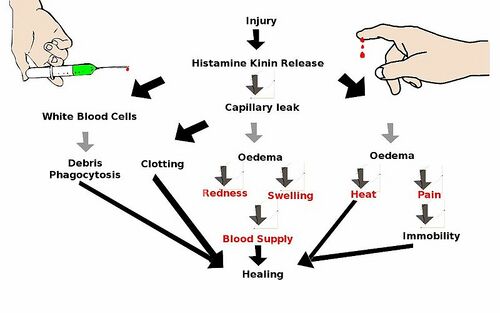Injury and Healing Within Sports Physiotherapy: Difference between revisions
No edit summary |
m (added photo) |
||
| Line 4: | Line 4: | ||
'''Top Contributors''' - {{Special:Contributors/{{FULLPAGENAME}}}} | '''Top Contributors''' - {{Special:Contributors/{{FULLPAGENAME}}}} | ||
</div> | </div> | ||
[[File:Inflammationchart.jpg|thumb|500x500px|inflammatory chart]] | |||
== POLICE == | == POLICE == | ||
During the acute phase discussed above, the [[RICE]]-method: Rest, Ice, Compression and Elevation was suggested. Most people are familiar with the acronym [[RICE]] when dealing with musculoskeletal injury, however, current thoughts have expanded the RICE acronym to the POLICE method: Protection, Optimal Loading, Ice, Compression, Elevation. Optimal loading or mechanical loading is the time where physiotherapists need to use good clinical decision making to assist with recovery and prevent chronic conditions from forming.<ref name=":2">Horsley, I. Injury and Healing in Sports Physiotherapy Course. Physioplus. 2022. | During the acute phase discussed above, the [[RICE]]-method: Rest, Ice, Compression and Elevation was suggested. Most people are familiar with the acronym [[RICE]] when dealing with musculoskeletal injury, however, current thoughts have expanded the RICE acronym to the POLICE method: Protection, Optimal Loading, Ice, Compression, Elevation. Optimal loading or mechanical loading is the time where physiotherapists need to use good clinical decision making to assist with recovery and prevent chronic conditions from forming.<ref name=":2">Horsley, I. Injury and Healing in Sports Physiotherapy Course. Physioplus. 2022. | ||
Revision as of 21:45, 20 February 2022
Original Editor - Rpbin Tacchetti
Top Contributors - Wanda van Niekerk, Robin Tacchetti, Lucinda hampton, Kim Jackson, Jess Bell, Ewa Jaraczewska and Tarina van der Stockt
POLICE[edit | edit source]
During the acute phase discussed above, the RICE-method: Rest, Ice, Compression and Elevation was suggested. Most people are familiar with the acronym RICE when dealing with musculoskeletal injury, however, current thoughts have expanded the RICE acronym to the POLICE method: Protection, Optimal Loading, Ice, Compression, Elevation. Optimal loading or mechanical loading is the time where physiotherapists need to use good clinical decision making to assist with recovery and prevent chronic conditions from forming.[1]
Mechanical Loading[edit | edit source]
Understanding the specific injured tissue helps target the appropriate timing for incremental loading. During this remodelling stage collagen transitions from immature type three to type one collagen.[1]Injured tissues need to learn how to adapt to mechanical loads to in order to return to pre-injury level. A load can be very light like a tickle, to a very high load like a manipulation. If the load is applied is too little or too much, it can result in inappropriate repair of the tissues and create a chronic condition. As physiotherapists, we can use many different techniques to apply loads such as massage and ultrasound. As tissues get stronger, the applied load can increase being careful not to go overboard. Too much tension can cause the collagen fibres to misalign causing adhesions leading to chronic conditions.[1]
Loading Feedback[edit | edit source]
Patient feedback is critical during this stage to ensure collagen alignment and proper healing. Asking the patient to monitor for swelling, stiffness and pain for 24 hours can help the therapist gauge the correct loading application. In addition, therapists can monitor swelling using tape measures.[1]
Healing Times[edit | edit source]
Healing times are dependent on the type of tissue involved.With proper management, different tissues will take different amounts of time to heal fully. Ian Horsley[1] estimates below the time expected per tissue:
Ligament: 1 year
Tendon: 2-3 years
Articular cartilage: greater than 3 years
Good clinical decision involves understanding the tissue, the timing to add mechanical loading, the amount of mechanical loading, monitoring for symptoms and asking for patient feedback all help give the best chance of tissue recovery to pre-injury level of strength.
Resources[edit | edit source]
- Soft Tissue Healing
- Figure Eight Measurement of the Hand
- Figure of Eight Method of Measuring Ankle Joint Swelling
Reference[edit | edit source]







